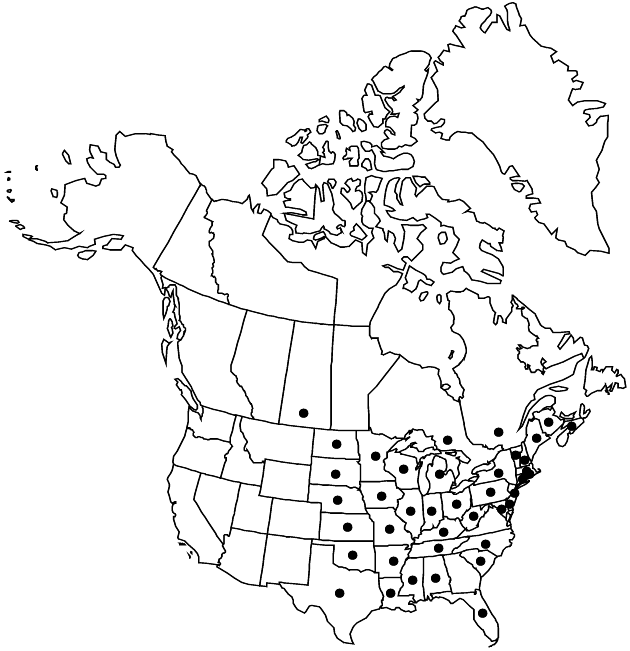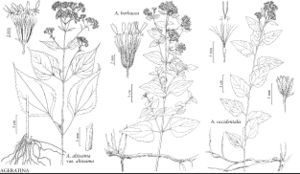Difference between revisions of "Ageratina altissima var. altissima"
FNA>Volume Importer |
FNA>Volume Importer |
||
| Line 8: | Line 8: | ||
|name=Ageratina altissima var. angustata | |name=Ageratina altissima var. angustata | ||
|authority=Fernald | |authority=Fernald | ||
| − | }}{{Treatment/ID/Synonym | + | }} {{Treatment/ID/Synonym |
|name=Eupatorium rugosum | |name=Eupatorium rugosum | ||
|authority=Reichard | |authority=Reichard | ||
| − | }}{{Treatment/ID/Synonym | + | }} {{Treatment/ID/Synonym |
|name=Eupatorium rugosum var. chlorolepis | |name=Eupatorium rugosum var. chlorolepis | ||
|authority=(B. L. Robinson) S. F. Blake | |authority=(B. L. Robinson) S. F. Blake | ||
| − | }}{{Treatment/ID/Synonym | + | }} {{Treatment/ID/Synonym |
|name=Eupatorium rugosum var. tomentellum | |name=Eupatorium rugosum var. tomentellum | ||
|authority=unknown | |authority=unknown | ||
| − | }}{{Treatment/ID/Synonym | + | }} {{Treatment/ID/Synonym |
|name=Eupatorium urticifolium | |name=Eupatorium urticifolium | ||
|authority=unknown | |authority=unknown | ||
| Line 35: | Line 35: | ||
|elevation=10–800 m | |elevation=10–800 m | ||
|distribution=N.B.;N.S.;Ont.;Que.;Sask.;Ala.;Ark.;Conn.;Del.;Fla.;Ill.;Ind.;Iowa;Kans.;Ky.;La.;Maine;Md.;Mass.;Mich.;Minn.;Miss.;Mo.;Nebr.;N.H.;N.J.;N.Y.;N.C.;N.Dak.;Ohio;Okla.;Pa.;R.I.;S.C.;S.Dak.;Tenn.;Tex.;Vt.;W.Va.;Wis. | |distribution=N.B.;N.S.;Ont.;Que.;Sask.;Ala.;Ark.;Conn.;Del.;Fla.;Ill.;Ind.;Iowa;Kans.;Ky.;La.;Maine;Md.;Mass.;Mich.;Minn.;Miss.;Mo.;Nebr.;N.H.;N.J.;N.Y.;N.C.;N.Dak.;Ohio;Okla.;Pa.;R.I.;S.C.;S.Dak.;Tenn.;Tex.;Vt.;W.Va.;Wis. | ||
| − | |discussion=<p>Plants with narrow leaves, generally in the southwest part of the range of Ageratina altissima, have been recognized as var. angustata and were so mapped by A. F. Clewell and J. W. Wooten (1971), who indicated that all var. angustata occurs west of the Mississippi River and that this taxon was completely congruent in distribution with var. altissima. The present treatment confirms the westward tendency toward size reduction and observes that narrow-leaved plants occur widely through the southeast United States (including Arkansas, Kentucky, Louisiana, North Carolina, Oklahoma, Tennessee, and Texas). The transition is gradual and the region of intergradation is wide. In Texas, where the leaves mostly are narrow, plants with broad, cordate leaves are scattered through the range.</p> | + | |discussion=<p>Plants with narrow leaves, generally in the southwest part of the range of <i>Ageratina altissima</i>, have been recognized as <i></i>var.<i> angustata</i> and were so mapped by A. F. Clewell and J. W. Wooten (1971), who indicated that all <i></i>var.<i> angustata</i> occurs west of the Mississippi River and that this taxon was completely congruent in distribution with <i></i>var.<i> altissima</i>. The present treatment confirms the westward tendency toward size reduction and observes that narrow-leaved plants occur widely through the southeast United States (including Arkansas, Kentucky, Louisiana, North Carolina, Oklahoma, Tennessee, and Texas). The transition is gradual and the region of intergradation is wide. In Texas, where the leaves mostly are narrow, plants with broad, cordate leaves are scattered through the range.</p> |
|tables= | |tables= | ||
|references= | |references= | ||
| Line 59: | Line 59: | ||
|publication year= | |publication year= | ||
|special status= | |special status= | ||
| − | |source xml=https://jpend@bitbucket.org/aafc-mbb/fna-data-curation.git/src/ | + | |source xml=https://jpend@bitbucket.org/aafc-mbb/fna-data-curation.git/src/8f726806613d60c220dc4493de13607dd3150896/coarse_grained_fna_xml/V19-20-21/V21_1391.xml |
|tribe=Asteraceae tribe Eupatorieae | |tribe=Asteraceae tribe Eupatorieae | ||
|genus=Ageratina | |genus=Ageratina | ||
Revision as of 15:32, 18 September 2019
Phyllaries 3–5 mm, apices not cuspidate.
Phenology: Flowering Jul–Oct(–Nov).
Habitat: Moist forests, cove forests
Elevation: 10–800 m
Distribution

N.B., N.S., Ont., Que., Sask., Ala., Ark., Conn., Del., Fla., Ill., Ind., Iowa, Kans., Ky., La., Maine, Md., Mass., Mich., Minn., Miss., Mo., Nebr., N.H., N.J., N.Y., N.C., N.Dak., Ohio, Okla., Pa., R.I., S.C., S.Dak., Tenn., Tex., Vt., W.Va., Wis.
Discussion
Plants with narrow leaves, generally in the southwest part of the range of Ageratina altissima, have been recognized as var. angustata and were so mapped by A. F. Clewell and J. W. Wooten (1971), who indicated that all var. angustata occurs west of the Mississippi River and that this taxon was completely congruent in distribution with var. altissima. The present treatment confirms the westward tendency toward size reduction and observes that narrow-leaved plants occur widely through the southeast United States (including Arkansas, Kentucky, Louisiana, North Carolina, Oklahoma, Tennessee, and Texas). The transition is gradual and the region of intergradation is wide. In Texas, where the leaves mostly are narrow, plants with broad, cordate leaves are scattered through the range.
Selected References
None.
